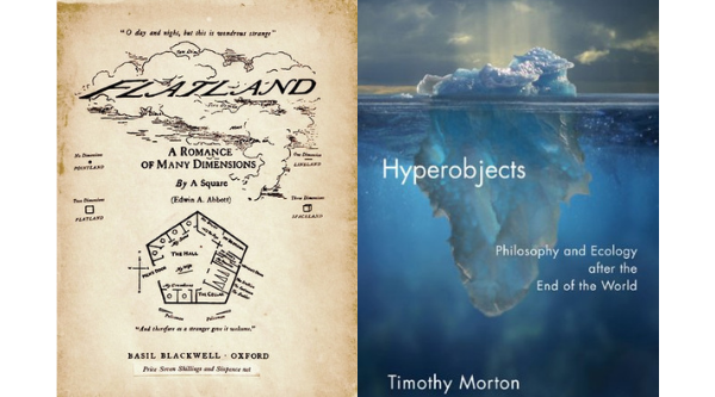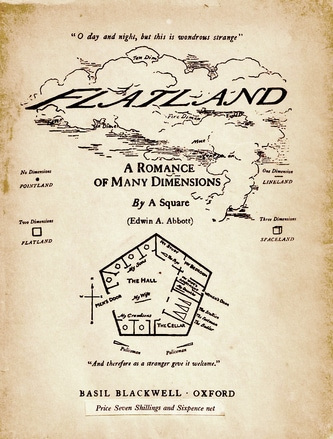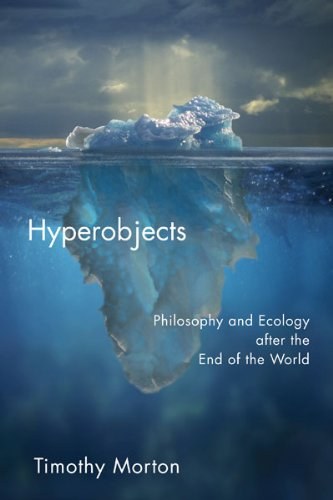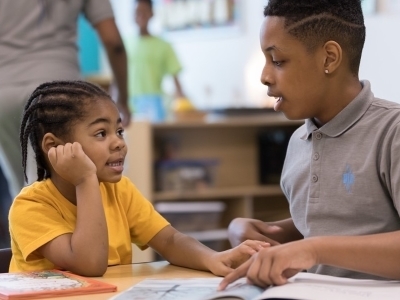Assessment, Metaphor, and Hyperobjects: Rethinking #RethinkAssessment
Topics

Educators are rethinking the purposes, forms, and nature of assessment. Beyond testing mastery of traditional content knowledge—an essential task, but not nearly sufficient—educators are designing assessment for learning as an integral part of the learning process.
Assessment isn't a thing you can hold in your hand (or in a binder or in a single policy). To truly rethink and transform it, we need a different way to understand it.
In the classic book, Flatland, Edwin Abbot Abbot posits a world of two dimensional beings. They exist on a flat plane, only able to see each other as edges of varying lengths or luminosity. They have no concept of “up” or “down.” One Flatlander, A. Square, encounters a sphere. But he doesn’t encounter the sphere, of course. The sphere passes through their plane, but all the Flatlander can see is the line created by the intersection.

In order to understand it as a sphere, the Flatlander must interpret the phenomenon correctly. He has to conceive that it’s a single object that is changing in size, rather than multiple discrete objects being seen in sequence. He has to understand that the line of the intersection is growing and shrinking because there is stuff “above” and “below” his plane of existence. Oh, yeah, he has to invent concepts of “above” and “below” and “up” and “down,” entirely speculative concepts. It’s as if we, looking at the intersection of three lines (x, y, and z), producing three right angles (the corner of a cube), could imagine a fourth line that produced a right angle to all of those right angles. We can NOT do that. But through analysis and reason we could know of it. Similarly, the Flatlanders can not, ever, experience the sphere as a sphere. They could only through reason know the sphere. And yet the sphere is real.
This is what it feels like, sometimes, to #RethinkAssessment.
Why am I telling you this?
You may have noticed a thread running through most of my writing here, that thread being #RethinkAssessment. Honestly, this has been my project for the last seven years, working on Quality Performance Assessment, the Assessment for Learning Project, and now Assessment for Good. The conversations are amazing. Cheryl Lupenui and I continue our examination of Ola Ka Honua, EDUCATION as ECOSYSTEM and ASSESSMENT as STORY have gone deeper than ever seemed possible.
And yet change is elusive, and seems to become more elusive as the pandemic continues. The forces of the status quo seem insistent that schools be open, kids be held accountable, teachers quit complaining, budgets remain stable, and everyone know their place. The status quo has a lot of inertia to it. It’s always easier to do nothing rather than something.
To combat this—or perhaps to navigate it—there’s been a lot of examination of the metaphors we use to talk about our work (like, whether we’re navigating or combatting). The metaphor is the thing that is not the thing. “Your poetry is a bright light in the darkness,” you might say to a student. It is not a bright light, but the metaphor says it shares salient qualities with a bright light. Metaphors guide you in your vision of what is possible, what is impossible, what options are available, what is likely, and what has value. If education is a science, for example, certain options are available to us and certain values accrue. If it is an art, different options and different values. If school is a machine, we behave in one way. If it is a garden, we behave in a different way. If school is a prison (as many kids feel), we behave according to that understanding.
Similarly, If #RethinkAssessment is a school improvement initiative, we do certain things and are inspired by certain models. If it is a movement, we do other things; we have different heroes. (Emma Goldman, anyone?) If I am an instructor of assessment, a consultant, an advocate, a poet, or an evangelist for Assessment for Good—different possibilities are implied. But is this enough? Is this metaphor play enough? Is our thought expansive enough? Is it at least leading to a place that is “enough?” By limiting ourselves to metaphors of the thing that is not the thing are we still trapping ourselves in hierarchical, hegemonic structures? What if Assessment isn’t a different thing, but a different kind of thing from what we’ve imagined? For example, perhaps Assessment is not a thing (an object), at all, but a hyperobject.
Whaaaatttt?
Timothy Morton’s Hyperobjects, is a wonderful—in fact, playful—meditation on why it is hard for humans to scale their perception and understanding beyond what a person can directly experience, and why this is dangerous for humans and every other thing. And it is directly applicable to education, generally, and assessment, specifically.
Morton, who writes primarily about ecology, describes hyperobjects as objects which are “massively distributed in time and space.” Examples would be global warming, plastic, the economy, or COVID-19. These things cannot be easily grasped in space or time. You can experience instances or effects of these things, but you cannot experience them as a whole. You can collect plastic bottles and recycle them, but the presence and impact of Plastic in the ecosystem is beyond our ken. You do not experience the Economy, partly because of its complexity, partly because of its size, partly because it is a different kind of thing from what you experience at a human scale. It is a hyperobject.

We imagine Assessment to be linear, graspable, and bounded in the way that things are. We imagine that we can predict how changes in one part of an assessment system will impact kids in a particular section of the district, just as we would predict how one billiard ball would impact every other ball on the table. But billiard balls (and pool tables) are objects. Assessment is a hyperobject. What are the qualities of a hyperobject? Morton lays out five.
- Viscous: Hyperobjects are ever present and unavoidable. We move through them, and they “stick” to us. We can’t get rid of them.
Assessment is slow moving, ever present, liquid, and inexorable. Assessment sticks to the kid, and colors every day for the teacher. It is constant and continuous. Surveillance or observation. Healthy or punitive. Ubiquitously curious, or oppressively surveilling—compelling the kid to sit, like Winston Smith, in the one spot of the room where the camera doesn’t reach. It is always on our mind—“Kids have to be held accountable!”—and always on the kids’ minds. “Is this going to be on the test?” In a way this is an extension of the evolutionary imperative to always be alert. How am I doing? What are they doing? Where did that bear go? You do the environment, or the environment does you. You do Assessment, or Assessment does you. - Non-local: Hyperobjects are widely dispersed. A hyperobject like Pollution can’t be in one place or another. You can’t have it in your house and then throw it “away.” As we’ve learned from the interconnectedness of ecosystems, there is no “away.” Even if you don’t see evidence of the thing itself, its effects permeate your existence.
Assessment, also, is not a thing that exists in one place, certainly not in the individual student. You can look at an assessment (a test or project) or at a description of an assessment process or at an assessment in progress or at an artifact from assessments. But you cannot point to a thing in your room and say, “That is Assessment.” It may be an example of assessment. It is not Assessment. Curriculum directors or consultants or teachers cannot say, “Let’s change Assessment.” And then go to the place where Assessment is stored and start tinkering. If only! - Temporally unfixed: Hyperobjects are not just dispersed through space, but through time. Carbon became a hyperobject when James Watts patented the steam engine in 1769, beginning carbon’s infusion into the atmosphere and every corner of the Earth. It will continue to exist as a hyperobject beyond the foreseeable future.
Assessment is never just the thing that’s happening now. The anticipation of an assessment (the past) can impact the performance on the assessment (the present) which impacts further outcomes for the kid (the future). Assessment exists before “the assessment,” during the assessment, and afterwards. This can be good or bad. The implications of Assessment are a threat that hangs in the air, or a promise between learners. The effects of Assessment last well beyond the Saturday morning of the SAT, or the timed run, or the capstone presentation. Does Assessment have a half-life? I am 53 and still cringe ever so slightly when I remember failing my drivers’ test 36 years ago. - Phased: Because hyperobjects are non-local and temporally unfixed, they sometimes feel uncanny. They are ungraspable or unexperience-able as a whole. They are imperceivable as a whole, but not inconceivable. Hyperobjects cannot be experienced, but are known through experience+reason+analysis+analogy+statistics.
Assessment also has this sense of uncanniness to it. We build up linear stories about assessment. We say things like, “Let’s design our assessment system.” And think it can be encompassed within a binder (back in the day) or SMS. But to see Assessment in a school, district, or state, we would have to be able to pull away from our own perspective. What happens to every kid impacts what happens to each kid. What happens in every classroom impacts what happens in each classroom. What happens in a classroom at every point in time impacts what happens in a classroom in each point in time. “What’s the big picture?” we ask, but it’s more than the Big Picture, or even the Very Complicated Picture. It’s like A. Square encountering a three dimensional sphere in Edward Abbott Abbott’s Flatland. “I’m above you.” And the square has to figure out what “above” means when there’s no way for him to experience or perceive it directly, but with experience+reason+analysis+analogy+statistics he can have knowledge of it and act upon it. - Interobjectivity: Just as humans (which are things) are made of cells (which are things) are made of molecules and atoms (also things), hyperobjects are made up of a bunch of human-scaled things (objects) in relationship. Humans have no difficulty scaling “down” to organs, cells, and molecules in relationship, but scaling “up”—to things which we are a part of, community, society, the environment, the solar system—is a challenge. Things are not just more interdependent than we imagine; they are more interdependent than we can imagine.
The horizon does not exist without a person to see it. It is a function of where you are standing, how elevated you are, the curvature of the Earth, weather conditions, geological and arboreal structures, etc. Assessment is a function of relationships, between people, objects, ideas, policy, feelings, families, professional judgement, chance, improvisation, etc. If your “assessment system” doesn’t account for this fundamental web of relationships then your view of Assessment is incomplete, and your attempts to improve, change, or replace it will be inadequate. It will be like replacing a sphere with a bunch of circles.
Again, why am I telling you this?
My goal for this essay is not to have you walk away thinking, “Yes! That’s it! Hyperobjects!” Rather, it’s to provoke an inquiry into the way we’ve been approaching this work. Our campaign to #RethinkAssessment has facilitated more through-roads than any other educational movement I’ve been a part of, but now what I’m feeling is not through-roads, but cul de sacs. It could be the movement—where we are at the moment. It could be the pandemic, which has certainly challenged our momentum. Also, it could be me (seriously, not a rhetorical self-deprecation move).
Is there a way to move more widely, acutely, and laterally (as in lateral thinking) in ways that upset the usual pattern of change dancing with the status quo? Is there a way to go more deeply into the radical ideas we’ve already plumbed?
The concept of mutuality—raised in our work on ecosystems and reinforced in the reading on hyperobjects—is profoundly powerful if we are willing to follow its implications all the way down. We haven’t been. More important, though, are the things we haven’t thought about and the ways we haven’t thought about them, yet. The Assessment for Learning Project, for example, began, basically, as a miraculous R&D project that quickly realized it had to unmoor itself from traditional accountability and psychometry. This led to ground breaking work. But we’ve reached a frontier, I feel, which requires a new measure of courage and a new method of travel. To dig deeper than ever before you need new tools. We’ve got ECOSYSTEM. We’ve got STORY. What else? What other tools will we need, and why is it so hard to find them? What is it that we’re still moored to?
1. FYI, much more happens in Flatland, which is delightful, and also, a romance and scathing political commentary.




